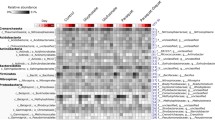Abstract
The fluorogenic model substrates, methylumbelliferyl [MUF]-β-D-glucoside, MUF-phosphate and MUF-sulphate, were used to investigate the activities of β-glucosidase, phosphatase and sulphatase, respectively, in Welsh peatland soils. The method was used to investigate depth dependent variations in enzyme activity in a riparian wetland, and flush channel wetland. The highest activities were found at depths of less than 10 cm, thus confirming other studies which suggest this upper depth to be the site of greatest microbial activity. The most serious limitation to the technique was found to be the (fluorescence) quenching effects of the phenolic materials that dominate peatland dissolved organic carbon. The problem necessitates the adoption of a time consuming quench correction procedure with every sample. Fluorogenic substrates have led to a greater understanding of the role of enzymes in other aquatic systems. It seems likely that they will prove of equal value in elucidating their role in nutrient cycling and the biogeochemistry of peatlands.
Similar content being viewed by others
References
Burns R G 1978 Soil Enzymes. Academic Press, London. 380p.
Chrost R G 1990 Microbial ectoenzymes in aquatic environments.In Aquatic Microbial Ecology; Biochemical and Molecular Approaches. Eds. JOverbeck and R JChrost. pp 47–78. Springer-Verlag, New York.
Chrost R J and Krambeck H J 1986 Fluorescence correction for measurements of enzyme activity in natural waters using methylumbelliferyl-substrates. Arch. Hydrobiol. 106, 79–90.
Clymo R S 1983 Peat.In Ecosystems of the World 4A; Mires: Swamp, Bog, Fen and Moor. Ed. D WGoodall. pp 159–224. Elsevier, Amsterdam.
Clymo R S and Reddaway E J F 1971 Productivity of sphagnum (bog-moss) and peat accumulation. Hidrobiologia 12, 181–192.
Dickinson C H 1979 Microorganisms in Peatlands.In Ecosystems of the World 4A. Ed. A J P Gore. pp 225–243. Elsevier, Amsterdam.
Gammelgaard A, Freeman C and Lock M A 1992 The measurement of electron transport system activity in sphagnum derived peat. Soil Biol. Biochem. 25, 505–507.
Hoppe H G 1983 Significance of exoenzymatic activities in the ecology of brackish water: Measurements by means of methylumbelliferyl substrates. Mar. Ecol. Prog. Ser. 11, 299–308.
King G M 1986 Characterization of ∝-glucosidase activity in intertidal marine sediments. Appl. Environ. Microbiol. 51, 373–380.
Marxsen J and Witzel K P 1990 Measurement of exoenzymatic activity in streambed sediments using methylumbelliferyl substrates. Arch. Hydrobiol. Beih. Ergeb. Limnol. 34, 21–28.
Marxsen J and Witzel K P 1991 Significance of extracellular enzymes for organic matter degradation and nutrient regeneration in small streams.In Microbial Enzymes in Aquatic Environments. Ed. R JChrost. pp 270–285, Springer, New York.
Meyer-Reil L A 1991 Ecological aspects of enzymatic activity in marine sediments.In Microbial Enzymes in Aquatic Environments. Ed. R JChrost. pp 84–95. Springer Verlag, New York.
Munster U, Einio P and Nurminen J 1989 Evaluation of the measurements of extracellular enzyme activities in a polyhumic lake by means of studies with 4-methylumbelliferyl substrates. Arch. Hydrobiol. 115, 321–337.
Peterson R C, Madsen B L, Wilzbach M A, Magadza C H D, Paarlberg A, Kullberg A and Cummins W K 1987 Stream management: emerging global similarities. Ambio 16, 166–179.
Pind A, Freeman C and Lock M A 1994 Enzymic degradation of phenolic materials in peatlands-measurement of phenol oxidase activity. Plant and Soil 159, 227–231.
Press M C, Henderson J and Lee J A 1985 Arylsulphatase activity in peat in relation to acidic deposition. Soil Biol. Biochem. 17, 99–103.
Sinsabaugh R L, Gollady S W and Linkins A 1991 Comparison of epilithic and epixylic biofilm development in boreal river. Freshwater Biol. 25, 179–187.
Somville M 1984 Measurement and study of substrate specificity of exoglucosidase activity in eutrophic water. Appl. Environ. Microbiol. 48, 1181–1185.
Tabatabai M A 1982 Soil enzymes.In Methods of Soil Analysis; Part 2, Chemical and Microbiological properties. 2nd ed. Ed. A LPage. pp 903–947. American Society of Agronomy, Soil Science Society of America, Madison, WI.
Tabatabai M A and Bremner J M 1970 Arylsulphatase activity of soils. Soil Sci. Soc. Am. Proc. 34, 225–229.
Author information
Authors and Affiliations
Rights and permissions
About this article
Cite this article
Freeman, C., Liska, G., Ostle, N.J. et al. The use of fluorogenic substrates for measuring enzyme activity in peatlands. Plant Soil 175, 147–152 (1995). https://doi.org/10.1007/BF02413020
Received:
Accepted:
Issue Date:
DOI: https://doi.org/10.1007/BF02413020




